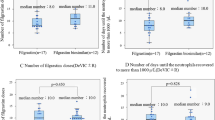Abstract
Filgrastim-sndz (Zarxio®) was approved by the FDA in March 2015 as a biosimilar product of its reference product, filgrastim (Neupogen®) for all five indications. The NCCN Clinical Practice Guidelines has incorporated filgrastim-sndz into its recommendations as a category 1 recommendation for use in settings of febrile neutropenia, myelosuppressive chemotherapy administration, and post-hematopoietic stem cell transplant (HSCT). As a cost-saving initiative, our institution switched from filgrastim to filgrastim-sndz for all indications starting in March 2016. The purpose of this study was to assess for any difference in clinical or safety outcomes between filgrastim and filgrastim-sndz. This is an IRB-approved, single institution, 1-year retrospective chart review (September 2015 to August 2016) conducted in hospitalized adults who received either filgrastim or filgrastim-sndz either for prophylaxis of chemotherapy-induced myelosuppression or for neutrophil recovery after autologous HSCT. Our data showed no differences in duration of G-CSF therapy (7.96 vs. 8.5 days, P = 0.36), white blood count (WBC) (8.99 vs. 8.04, P = 0.28), absolute neutrophil count (ANC) (7.62 vs. 6.91 × 109/L, P = 0.36) at the time of granulocyte-colony stimulating factor (G-CSF) discontinuation, or safety of filgrastim and filgrastim-sndz. The efficacy and safety of filgrastim and filgrastim-sndz were similar for prophylaxis of chemotherapy-induced neutropenia and neutrophil recovery post-autologous HSCT.
Similar content being viewed by others
References
Maschmeyer G, Rolston K. Myeloid growth factors. Infections in Hematology. Springer Berlin Heidelberg: 2015
Nahon S et al (2016) Zarzio®, biosimilar of filgrastim, in prophylaxis of chemotherapy-induced neutropenia in routine practice: a French prospective multicenter study. Support Care Cancer 24:1991–1998
Elayan MM et al (2015) Tbo-filgrastim versus filgrastim during mobilization and neutrophil engraftment for autologous stem cell transplantation. Biol Blood Marrow Transplant 21:1921–1925
National Comprehensive Cancer Network (NCCN). NCCN Clinical Practice Guidelines in Oncology: myeloid growth factors. Version 1.2017. NCCN.org
Renwick W, Pettengell R, Green M (2009) Use of filgrastim and pegfilgrastim to support delivery of chemotherapy. BioDrugs 23:175–186
Hirsch BR, Lyman GH (2013) Will biosimilars gain momentum? J Natl Compr Cancer Netw 11:1291–1297
Sorgel F et al (2015) Comparability of biosimilar filgrastim with originator filgrastim: protein characterization, pharmacodynamics, and pharmacokinetics. BioDrugs 29:123–131
Zelenetz AD (2016) The role of biosimilars. J Natl Compr Cancer Netw 14(5):626–629
Blackstone EA, Fuhr JP Jr (2012) Innovation and competition: will biosimilars succeed? Biotechnol Healthc 9:24–27
Awad M et al (2017) Zarxio (filgrastim-sndz): the first biosimilar approved by the FDA. PT 42:19–23
Blackwell K et al (2015) Comparison of EP2006, a filgrastim biosimilar, to the reference: phase III, randomized, double-blind clinical study in the prevention of severe neutropenia in patients with breast cancer receiving myelosuppressive chemotherapy. Ann Oncol 26(9):1948–1953. https://doi.org/10.1093/annonc/mdv281
Harada K et al (2016) Comparison of transplant outcomes and economic costs between biosimilar and originator filgrastim in allogeneic hematopoietic stem cell transplantation. Int J Hematol 104:709–719
Yoshimura H et al (2017) Evaluation of a biosimilar granulocyte colony-stimulating factor (filgrastim XM02) for peripheral blood stem cell mobilization and transplantation. J Blood Med 8:5–12
Author information
Authors and Affiliations
Corresponding author
Ethics declarations
Conflict of interest
The authors declare that they have no conflict of interest.
Rights and permissions
About this article
Cite this article
Zecchini, J., Yum, K., Steinberg, A. et al. A single-center, retrospective analysis to compare the efficacy and safety of filgrastim-sndz to filgrastim for prophylaxis of chemotherapy-induced neutropenia and for neutrophil recovery following autologous stem cell transplantation. Support Care Cancer 26, 1013–1016 (2018). https://doi.org/10.1007/s00520-017-3923-1
Received:
Accepted:
Published:
Issue Date:
DOI: https://doi.org/10.1007/s00520-017-3923-1




